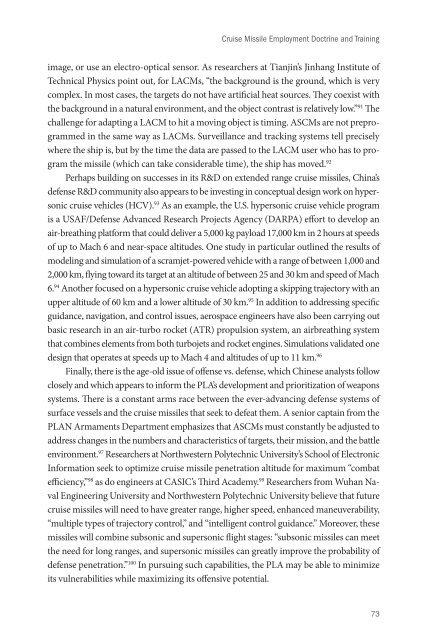You also want an ePaper? Increase the reach of your titles
YUMPU automatically turns print PDFs into web optimized ePapers that Google loves.
Cruise Missile Employment Doctrine and Training<br />
image, or use an electro-optical sensor. As researchers at Tianjin’s Jinhang Institute of<br />
Technical Physics point out, for LACMs, “the background is the ground, which is very<br />
complex. In most cases, the targets do not have artificial heat sources. They coexist with<br />
the background in a natural environment, and the object contrast is relatively low.” 91 The<br />
challenge for adapting a LACM to hit a moving object is timing. ASCMs are not preprogrammed<br />
in the same way as LACMs. Surveillance and tracking systems tell precisely<br />
where the ship is, but by the time the data are passed to the LACM user who has to program<br />
the missile (which can take considerable time), the ship has moved. 92<br />
Perhaps building on successes in its R&D on extended range cruise missiles, China’s<br />
defense R&D community also appears to be investing in conceptual design work on hypersonic<br />
cruise vehicles (HCV). 93 As an example, the U.S. hypersonic cruise vehicle program<br />
is a USAF/Defense Advanced Research Projects Agency (DARPA) effort to develop an<br />
air-breathing platform that could deliver a 5,000 kg payload 17,000 km in 2 hours at speeds<br />
of up to Mach 6 and near-space altitudes. One study in particular outlined the results of<br />
modeling and simulation of a scramjet-powered vehicle with a range of between 1,000 and<br />
2,000 km, flying toward its target at an altitude of between 25 and 30 km and speed of Mach<br />
6. 94 Another focused on a hypersonic cruise vehicle adopting a skipping trajectory with an<br />
upper altitude of 60 km and a lower altitude of 30 km. 95 In addition to addressing specific<br />
guidance, navigation, and control issues, aerospace engineers have also been carrying out<br />
basic research in an air-turbo rocket (ATR) propulsion system, an airbreathing system<br />
that combines elements from both turbojets and rocket engines. Simulations validated one<br />
design that operates at speeds up to Mach 4 and altitudes of up to 11 km. 96<br />
Finally, there is the age-old issue of offense vs. defense, which Chinese analysts follow<br />
closely and which appears to inform the PLA’s development and prioritization of weapons<br />
systems. There is a constant arms race between the ever-advancing defense systems of<br />
surface vessels and the cruise missiles that seek to defeat them. A senior captain from the<br />
PLAN Armaments Department emphasizes that ASCMs must constantly be adjusted to<br />
address changes in the numbers and characteristics of targets, their mission, and the battle<br />
environment. 97 Researchers at Northwestern Polytechnic University’s School of Electronic<br />
Information seek to optimize cruise missile penetration altitude for maximum “combat<br />
efficiency,” 98 as do engineers at CASIC’s Third Academy. 99 Researchers from Wuhan Naval<br />
Engineering University and Northwestern Polytechnic University believe that future<br />
cruise missiles will need to have greater range, higher speed, enhanced maneuverability,<br />
“multiple types of trajectory control,” and “intelligent control guidance.” Moreover, these<br />
missiles will combine subsonic and supersonic flight stages: “subsonic missiles can meet<br />
the need for long ranges, and supersonic missiles can greatly improve the probability of<br />
defense penetration.” 100 In pursuing such capabilities, the PLA may be able to minimize<br />
its vulnerabilities while maximizing its offensive potential.<br />
73


